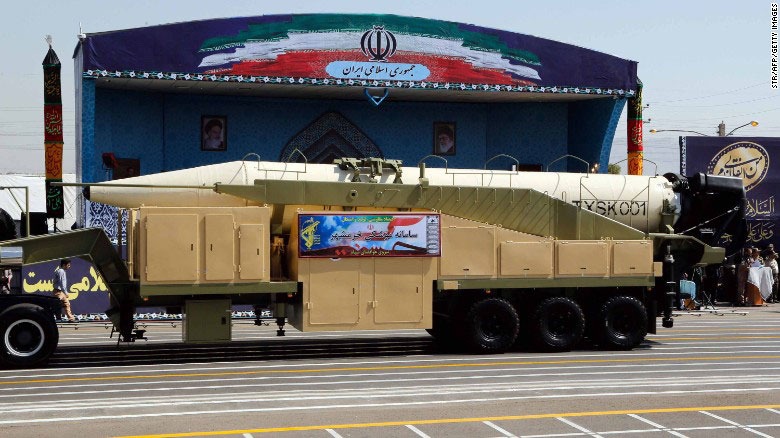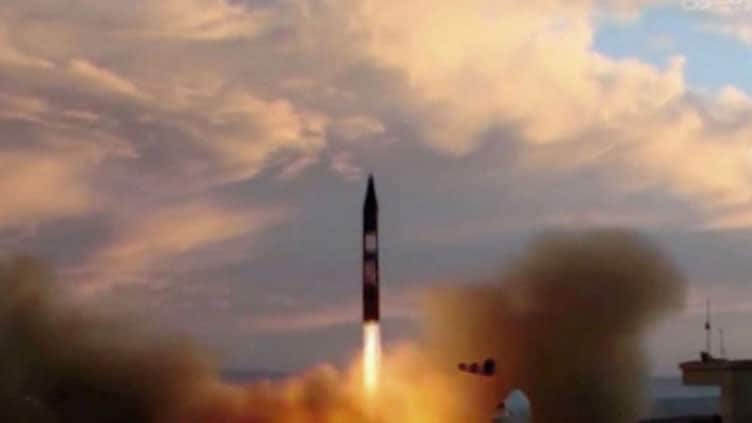Khorramshahr | Missile Threat (original) (raw)
The Khorramshahr is an Iranian liquid-fueled, medium-range ballistic missile. It is likely derived from the North Korean Musudan (BM-25) missile. Iran first test fired the missile in January 2017, and first publicly displayed it at a September 2017 military parade in Tehran. It has a reported range of 2,000 km. In 2019, Iran displayed a version of Khorramshahr with a smaller reentry vehicle that could reach a range of 3,000 km.
Khorramshahr at a Glance
Originated from
North Korea, Iran
Possessed by
Iran
Class
Medium-Range Ballistic Missile (MRBM)
Basing
Road-mobile, ground-launched
Length
13 – 13.5 m
Diameter
1.5 – 1.8 m
Launch weight
15,000 – 20,000 kg
Payload
1,800 kg
Warhead
High explosive (HE), submunitions
Propulsion
One- or two-stage, liquid propellant
Range
2,000 – 3,000 km
Status
In development

Khorramshahr missile paraded in September 2017. Photo: Tasnim News Agency

Iran test launches a Khorramshahr missile in January 2017. Photo: IRIB

Two versions of the Khorramshahr missile paraded in September 2019. Photo: Fars News Agency via Jane’s
Khorramshahr Development
Iran’s Khorramshahr missile is likely derived from North Korea’s Musudan (BM-25), which itself has origins in the Soviet R-27/RSM-25 (NATO designation: SS-N-6 ‘Serb’) submarine-launched ballistic missile (SLBM). The R-27 entered operational service in the USSR in 1968.1 Reports indicate that North Korea was developing a ground-based R-27, now called “Musudan,” as early as 2003. Iran likely purchased 18 of these missiles and related equipment from North Korea around 2005.2 Iran first tested the Musudan on May 17, 2007, and again in April and July 2016.3 Iran subsequently modified the missile and renamed it ‘Khorramshahr.’
Iran first displayed the Khorramshahr on September 22, 2017 during the country’s 37th anniversary of the Iran-Iraq War.4 The missile is named after the capital city of Khorramshahr County, Khuzestan Province, which Iraq had occupied between October 1980 and May 1982.
Since the Khorramshahr is based on the intermediate-range Musudan, which has an estimated range of 2,500 to 4,000 km, analysts have questioned why Iranian officials mark the missile’s maximum range at 2,000 km. One hypothesis focuses on potential Iranian modifications. IRGC Commander of the Aerospace Division, Brigadier General Amir Ali Hajizadeh stated that the Iranian variant “has become smaller in size and more tactical,” which may explain the missile’s decreased range.5 A second theory asserts that Iranian officials do not want to raise concern in Europe about their missile program, and thus are purposely underestimating the range. “I am not sure why the Iranians are lying about the range,” one U.S. official told Fox News. “I think they don’t want to piss the Europeans off.”6
Despite its clear connection to the North Korean Musudan, Iranian officials nonetheless claim that the Khorramshahr was indigenously developed. During the September 2017 unveiling of Khorramshahr, Brigadier General Hajizadeh asserted, “Today, our country’s missile power is completely domestic from concept to product. There are no sections in these areas that are not indigenous.”7
The Khorramshahr was first reportedly test fired on January 29, 2017, flying about 950 km before exploding.8 It was fired from a test site near Semnan, 225 km east of Tehran. Commenting anonymously, a U.S. military official said the missile had been previously launched in July 2016, but this was reported as an Iranian Musudan test.9 Iranian state-run television showed video footage of a Khorramshahr test on September 23, 2017, but U.S. officials told CNN and Fox News there was ‘no indication’ a ballistic missile had been fired at that time. Additionally, the footage of the test dated back to the failed January 2017 launch.10
In February 2019, Iran showed footage of a possible Khorramshahr test during its Eghtedar 40 exhibition. The missile displayed in the footage and on a poster at the exhibition had a smaller warhead section and a finned reentry vehicle similar to the Emad.11 In March 2019, France, Germany, and the United Kingdom submitted a joint letter alleging that Iran had displayed a new version of the Khorramshahr missile with a smaller reentry vehicle. Photos of the new configuration emerged from a September 2019 parade.12 According to the joint letter, the smaller and lighter reentry vehicle could increase the missile’s range from 2,000 km to 3,000 km. In August 2020, Iranian state media released another video potentially showing a test of this new Khorramshahr-2 variant and claimed it was able to hit a 40×40 m target.13
Specifications
The Khorramshahr has a reported length of 13 m, a body diameter of 1.5-2.0 m, and launch weight of approximately 19,000-26,000 kg.14 According to Iranian officials, the missile has a range of 2,000 km and is capable of carrying multiple warheads of up to 1,800 kg.15 However, the range may be higher (around 2,500 km), and the “multiple warheads” claim is most likely a reference to a submunitions warhead, rather than multiple independently targetable reentry vehicle (MIRV) technology. The Khorramshahr is liquid-fueled and likely two-staged. Iranian media reports claim the missile has radar-evading capabilities and terminal guidance.16 If the guidance relies on an older inertial navigation system, however, the Khorramshahr’s accuracy could be quite poor, approximately 1,500 m circular error probable.17
Service History
The Khorramshahr, like all of Iran’s strategic, longer ranged missiles, is operated and maintained by the IRGC’s Aerospace Force. Iran’s state-run Press TV reported that the missile would soon be operational, but did not provide any specific projections.18
Footnotes
- “Musudan (BM-25),”in IHS Jane’s Weapons: Strategic 2015-2016, ed. Jane’s C O’Halloran (United Kingdom: IHS, 2016), 43.
- Ibid.
- CSIS Missile Defense Project, “Iranian Missile Launches: 1988-Present,” Missile Threat, August 17, 2017, https://missilethreat.csis.org/iranian-missile-launches-1988-present/.[](#easy-footnote-3-2982)
- Joseph Trevithick, ”Iran’s New Ballistic Missile Looks a Lot Like a Modified North Korean One,” The Drive, September 23, 2017, http://www.thedrive.com/the-war-zone/14572/irans-new-ballistic-missile-looks-a-lot-like-a-modified-north-korean-one%20—%20on%20testing%209/23.[](#easy-footnote-4-2982)
- Daniel Uria, “Iran conducts successful test of Khorramshahr ballistic missile,” UPI, September 23, 2017, https://www.upi.com/Top\_News/World-News/2017/09/23/Iran-conducts-successful-test-of-Khorramshahr-ballistic-missile/6931506170457/.[](#easy-footnote-5-2982)
- Lucas Tomlinson, “Iran’s supposed missile launch was fake, US officials say,” Fox News, September 26, 2017, http://www.foxnews.com/politics/2017/09/25/irans-supposed-missile-launch-was-fake-us-officials-say.html.[](#easy-footnote-6-2982)
- Press TV, “Iran’s missile development multiplied after US threats: Commander,” September 25, 2017, http://www.presstv.ir/Detail/2017/09/25/536417/Iran-IRGC-Aerospace-Division-Hajizadeh-Khorramshahr.[](#easy-footnote-7-2982)
- Trevithick.
- Idrees Ali, “Iran tested medium-range ballistic missile: U.S. official,” Reuters, January 30, 2017, http://www.reuters.com/article/us-usa-iran-missiles/iran-tested-medium-range-ballistic-missile-u-s-official-idUSKBN15E2EZ?feedType=RSS&feedName=worldNews&utm\_source=Twitter&utm\_medium=Social&utm\_campaign=Feed%3A+Reuters%2FworldNews+%28Reuters+World+News%29; CSIS Missile Defense Project.
- Barbara Starr, “US sees ‘no indication’ Iran launched a ballistic missile, despite Trump tweet,” CNN, September 25, 2017, http://www.cnn.com/2017/09/25/politics/us-iranian-missile-launch-fake/index.html; Lucas Tomlinson, “Iran’s supposed missile launch was fake, US officials say,” Fox News, September 25, 2017, http://www.foxnews.com/politics/2017/09/25/irans-supposed-missile-launch-was-fake-us-officials-say.html.[](#easy-footnote-10-2982)
- The International Institute for Strategic Studies, Open-Source Analysis of Iran’s Missile and UAV Capabilities and Proliferation (East Sussex: Hastings Print, April 2021), 14.
- Jeremy Binnie, “Iran parades Khorramshahr ballistic missile with new RV,” Jane’s Defence News, September 24, 2019, https://www.janes.com/defence-news/news-detail/iran-parades-khorramshahr-ballistic-missile-with-new-rv.[](#easy-footnote-12-2982)
- The International Institute for Strategic Studies, Open-Source Analysis of Iran’s Missile and UAV Capabilities and Proliferation, April 2021, 14.
- CSIS Missile Defense Project, “Musudan (BM-25),” Missile Threat, August 8, 2016, https://missilethreat.csis.org/missile/musudan/; Ibid.
- Ali Arouzi, “Iran Shows Off Khorramshahr Ballistic Missile After Trump Speech,” NBC, September 22, 2017, https://www.nbcnews.com/news/world/iran-shows-khorramshahr-ballistic-missile-after-trump-speech-n803701; Army Recognition, “Iran Test-fired of new Khorramshahr ballistic missile,” September 23, 2017, https://www.armyrecognition.com/september\_2017\_global\_defense\_security\_news\_industry/iran\_test-fired\_of\_new\_khorramshahr\_ballistic\_missile.html.[](#easy-footnote-15-2982)
- The Iran Project, “Minister says Iran’s new ballistic missile ‘Strategic Weapon’,” September 23, 2017, http://theiranproject.com/blog/2017/09/23/minister-says-irans-new-ballistic-missile-strategic-weapon/.[](#easy-footnote-16-2982)
- Jane’s Weapons: Strategic, 44.
- Press TV, “Iran successfully test-fires new ballistic missile: Video,” September 23, 2017, http://www.presstv.com/Detail/2017/09/23/536111/Iran-ballistic-missile-testfire.[](#easy-footnote-18-2982)